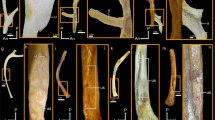Abstract
Gogiid eocrinoids (Lower and Middle Cambrian) are basal echinoderms that document development of pentamerism, origin and emplacement of primitive respiratory structures (epispires), development of blastozoan stalks/stems and exothecal brachioles. By Lower Ordovician they (gogiids) show reduction in epispires. By Middle Ordovician epispires are lost and hollowed longitudinal and latitudinal rays across the sutural plates align into (especially) thecal-length respiratory structures that define the Ascocystitidae. These flexible animals can attain thecal lengths of 180 mm and internal volumes of 60+ cc which argues for some type of internal body fluid circulation—probably by muscular constriction.

Similar content being viewed by others
REFERENCES
Allaire, N., Lefebvre, B., Nardin, E., Martin, E., Vaucher, R., and Escarguel, G., Morphological disparity and systematic revision of the eocrinoid Rhopalocystis (Echinodermata, Blastozoa) from the Lower Ordovician of the central Anti-Atlas (Morocco), J. Paleontol., 2017, vol. 91, no. 4, pp. 685–714.
Barrande, J., Classe des Echinodermes. Ordre des cystidées: ion Systême silurien du centre de la Bohême, Řivnáč (Prague), Gerhard (Leipzig), 1887, Pt. 1, vol. 7, 233 pp., 39 pls.
Bottjer, D., Hagadorn, J., and Dornbos, S., The Cambrian substrate revolution, Geology Today, 2000, vol. 19, no. 9, pp. 1–7.
Chauvel, J., Rhopalocystis Ubaghs: un Echinoderm Eocrinïde [Eocrinoïde] du Trémadocien de l’Anti-Atlas marocain, Mem. B. R. G. M., 1971, vol. 73, pp. 43–46.
Chauvel, J., Compléments sur les Echinodermes du Paléozoïque marocain (Diploporites, Eocrinoïdes, Edrioasteroides), Notes Mem. Serv. Gtol. (Marocco), 1978, Rabat, vol. 39, pp. 43–46.
Chauvel, J. and Regnault, S., Variabilité du gentre [genre?] Rholalocystis Ubaghs, Eocrinïde [Eocrinoïde?] du Trémadocien de l’Anti-Atlas Marocain [marocain], Geobios, 1986, vol. 19, fasc. 6, pp. 863–870.
Coyne, K., Qin, X., and Waite, J., Extensible collagen in mussel byssus: a natural block copolymer, Science, 1997, vol. 277, pp. 1830–1832.
Dzik, J. and Orłowski, S., The Late Cambrian eocrinoid Cambrocrinus. Acta Palaeont, Polonica, 1993, vol. 38, nos. 1/2, pp. 21–34.
Farmanfarmaian, A., The Respiratory Physiology of Echinoderms, in Phylogeny of Echinodermata, Boolootian, R., Ed., N.Y.: Wiley, 1966, pp. 245–265.
Frest, T., Ampheristocystis, a Silurian (Lower Wenlock) eocrinoid (Echinodermata, Blastozoa), Geol. J., 2005, vol. 40, pp. 301–329.
Nohejlová, M. and Fatka, O., Ontogeny and morphology of Cambrian eocrinoid Akradocrinus (Barrandian area, Czech Republic), Bull. Geosci., 2016, vol. 91, no. 1, pp. 141–152.
Orłowski, S., Upper Cambrian fauna of the Holy Cross Mts, Acta Geol. Pol., 1968, vol. 18, no. 2, pp. 257–299.
Parsley, R., Ontogeny, functional morphology, and comparative morphology of lower (Stage 4) and basal (Stage 5) Cambrian gogiids, Guizhou Province, China J. Paleontol., 2012, vol. 86, no. 4, pp. 569–583.
Parsley, R., Flume studies using 1:1 scale models to determine feeding posture and mode of attachment in Lower and basal Middle Cambrian gogiids from Guizhou Province, China Abstracts Programs, 2013, vol. 45, no. 7, Geol. Soc. America.
Parsley, R., Flume studies using 1:1 scale models of Series 2 and basal Series 3 Cambrian gogiid eocrinoids from Guizhou Province, China to determine feeding posture and mode of attachment, Palaeoworld, 2015, vol. 24, no. 4, pp. 400–407.
Parsley, R. and Prokop, R., Functional morphology and paleoecology of some sessile Middle Cambrian echinoderms from the Barrandian region of Bohemia, Bull. Geosci., 2004, vol. 79, no. 3, pp. 147–156.
Parsley, R. and Zhao, Y., Long-stemmed eocrinoids in the basal Middle Cambrian Kaili Biota, Taijiang County, Guizhou Province, China, J. Paleontol., 2006, vol. 80, no. 6, pp. 1058–1071.
Parsley, R. and Nardin, E., Size matters: Morphology, functional morphology and paleoecology of Ascocystites (Ascocystida, Eocrinoidea) from the Upper Ordovician of Morocco, Abstracts with Programs, 2016, vol. 48, no. 7, Geol. Soc. America. https://doi.org/10.1130/abs/2016AM-282182
Regnault, S., Morphologie et ontogenese des ascocystitidae (Eocrinoidea): Données fournies par l’étude de faunes de l’Ordovicien du massif Armoricain (France), Revue de Paléobiologie, 1990, vol. 9, no. 2, pp. 349–358.
Regnault, S., Presence de l’éocrinoïde ascocystites Barrande (Echinodermata, Blastozoa) dans l’Ordovicien supérieur (Caracoc) de l’Anti-Atlas (Maroc): premières données, Ann. de Paleon., 2007, vol. 93, pp. 215–227.
Sprinkle, J., Morphology and Evolution of Blastozoan Echinoderms, Special Publication, M.C. Z., Cambridge, Massachusetts, USA: Harvard Univ., 1973.
Sprinkle, J., Parsley, R., Zhao, Y., and Peng, J., Revision of Lyracystid eocrinoids from the Middle Cambrian of South China and western Laurentia, J. Paleontol., 2011, vol. 85, no. 2, pp. 250–255.
Ubaghs, G., Rhopalocystis destombesi n.g. n. s. éocrinoide de l’Ordovicien inférieur (Trémadocien supérieur) du Sud Marocain: Notes et Mém. du Serv géol. du Maroc, 1963, vol. 172, pp. 25–45.
Ubaghs, G., Eocrinoidea, Moore, R.C., Ed., Treatise on Invertebrate Paleontology, University of Kansas and Geological Society of America, 1967, vol. S, pp. S455–S495.
Zhao, Y., Huang, Y., and Gong, X., Echinoderm fossils of the Kaili Fauna from Taijiang, Guizhou, Acta Palaeontologica Sinica, 1996, vol. 33, no. 3, pp. 305–324.
Zhao, Y-L., Parsley, R.L., and Peng, J., Early Cambrian eocrinoids from Guizhou Province, China, Palaeogeogr., Palaeoclimatol., Palaeoecol., 2007, vol. 254, pp. 317–327.
Zhao, Y-L., Parsley, R.L., and Peng, J., Basal Middle Cambrian short-stalked eocrinoids from the Kaili Biota, Taijiang County, Guizhou Province, China J. Paleontol., 2008, vol. 82, no. 2, pp. 369–376.
Zhao, Y-L., Peng, J., Wu, M., Luo, X., Wen, R., and Liu, Y., A new type of Echinoderm from the Balang Formation in Cambrian at Xiasi Town, Majiang County, Guizhou Province, China Earth Sci. J China, 2015, vol. 40, no. 2, pp. 249–260.
ACKNOWLEDGMENTS
Mark Florence, Deputy Collections Manager, Invertebrates, of the Department of Paleobiology, National Museum of Natural History, Smithsonian Institution, pointed out the specimens of Ascocystites, made them available for study and facilitated their latex casting and photography. Mary Lawson, Department of Paleobiology, NMNH, (Retired), greatly improved the manuscript.
Author information
Authors and Affiliations
Corresponding author
Rights and permissions
About this article
Cite this article
Parsley, R.L. Evolution, Functional Morphology and Paedomorphism in the Gogiid-Ascocystitid Lineage (Eocrinoidea; Cambrian-Ordovician). Paleontol. J. 55, 966–976 (2021). https://doi.org/10.1134/S0031030121090100
Received:
Revised:
Accepted:
Published:
Issue Date:
DOI: https://doi.org/10.1134/S0031030121090100




